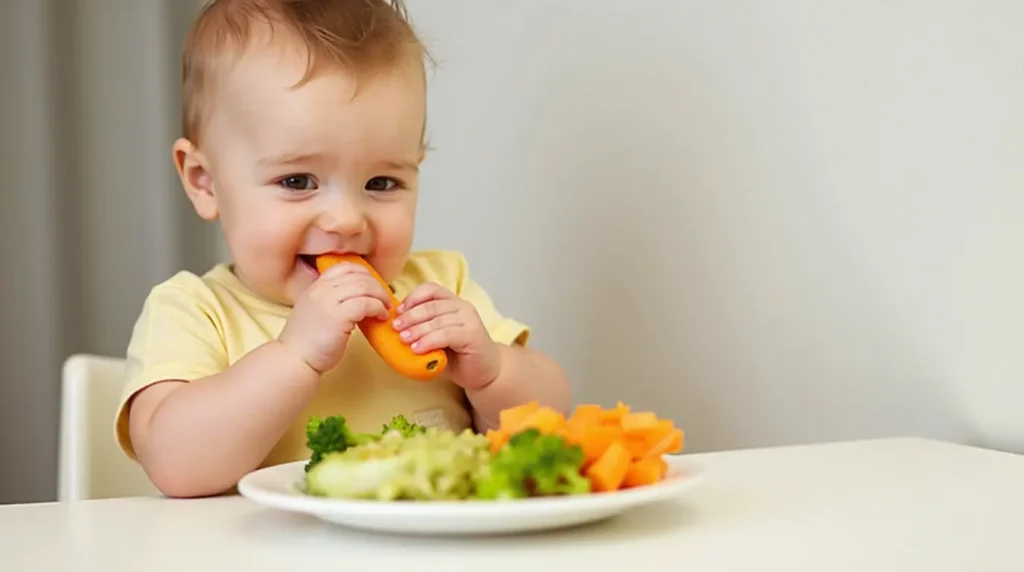
Baby-led weaning (BLW) is an approach to introducing solid foods where babies feed themselves from the very beginning, unlike traditional weaning, which often involves spoon-feeding purees. BLW allows infants to explore whole foods at their own pace by providing appropriately sized portions of family meals. This method empowers babies to control how much they eat and encourages independence. As with any parenting decision, there are advantages and disadvantages. This comprehensive guide will explore the Baby-Led Weaning Pros and Cons, helping parents make an informed choice for their child’s nutritional journey.
Thank you for reading this post, don't forget to subscribe!Promotes Fine Motor Skills Development
One of the standout advantages of baby-led weaning is its role in enhancing fine motor skills. Babies grasp, pick up, and maneuver foods of various shapes and textures, strengthening their pincer grip and hand-eye coordination. Over time, these skills translate to more precise movements, aiding overall development.
By exposing babies to a wide range of textures, colors, and flavors, baby-led weaning fosters adventurous eaters. Research suggests that early exposure to diverse foods can reduce picky eating behaviors and instill a lifelong preference for balanced diets.
Simplifies Meal Preparation for Families
For parents, baby-led weaning offers the practical benefit of preparing one meal for the whole family. Instead of cooking separate purees, caregivers can adapt family recipes by modifying seasonings or cutting foods into baby-friendly sizes, saving time and effort.
Potential Drawbacks and Challenges of Baby-Led Weaning

Risk of Choking: Myths and Realities
One of the most common concerns about BLW is the potential choking hazard.
Monitoring babies during mealtime and offering age-appropriate foods is crucial.
Research indicates that BLW does not increase choking risks compared to traditional methods.
Proper education and preparation alleviate much of this fear.
Mess Management: What to Expect
It’s no secret that baby-led weaning can be messy. As babies explore and experiment with food, spills, and smears are inevitable. However, investing in high-quality bibs, easy-to-clean surfaces, and patience can help manage the chaos.
Nutritional Gaps: Ensuring Balance in Baby’s Diet
Without careful planning, there’s a risk of nutrient deficiencies, especially for iron, zinc, and other essential vitamins. Parents should prioritize iron-rich foods like soft-cooked meats, lentils, and fortified cereals to meet their baby’s nutritional needs.
Baby-Led Weaning vs Traditional Weaning
Traditional weaning relies on spoon-feeding purees, gradually transitioning to solids. Baby-led weaning skips purees entirely, allowing babies to engage directly with solid foods. Both methods have their merits, and combining elements can offer a balanced approach tailored to individual baby needs.
When to Start Baby-Led Weaning? Signs of Readiness
The ideal time to begin BLW is around six months, coinciding with a baby’s developmental milestones. Signs of readiness include:
- Sitting up independently without support.
- Demonstrating good head and neck control.
- Showing interest in family meals and reaching for food.
- Loss of the tongue-thrust reflex, which pushes food out of the mouth.
Best Practices for Successful Baby-Led Weaning

Introducing Solid Foods Safely
Safety is paramount during baby-led weaning. Follow these guidelines to minimize risks:
- Cut foods into appropriate sizes: stick-shaped pieces for easy grasping.
- Avoid hard, round foods like whole grapes or nuts.
- Always supervise your baby during meals.
Introduce nutrient-dense foods to support growth and development.
Excellent options include:
- Steamed vegetables (carrots, broccoli, sweet potatoes)
- Soft fruits (banana, avocado, ripe pears)
- Protein sources (shredded chicken, tofu, scrambled eggs)
Common Myths About Baby-Led Weaning Debunked
First Myth: Babies Will Choke More Often with BLW
With proper preparation and supervision, BLW is no more dangerous than traditional weaning. Offering age-appropriate foods ensures safety.
Myth 2: BLW Leads to Nutritional Deficiencies
A well-planned baby-led weaning diet can provide all the necessary nutrients. Incorporating iron-rich and varied foods is key.
Myth 3: BLW Is Too Messy to Be Practical
While messiness is a reality, it’s manageable with the right tools and strategies.
The Pros of Baby-Led Weaning
Encourages Independence and Motor Skills
One of the most celebrated benefits of BLW is the opportunity it provides for infants to develop fine motor skills. Picking up pieces of food enhances hand-eye coordination, grip strength, and dexterity. Additionally, allowing babies to feed themselves fosters a sense of independence and self-confidence as they learn to control their eating.
Promotes Healthy Eating Habits
BLW introduces babies to a wide variety of textures and flavors early on. By participating in family meals, infants become accustomed to eating the same nutritious foods as the rest of the household. Over time, this approach can lead to less picky eating and a willingness to try new foods. Furthermore, it encourages babies to listen to their natural hunger and fullness cues, which may reduce the risk of overeating in the future.
Simplifies Mealtime Preparation
With BLW, preparing separate purees or buying commercial baby food is unnecessary. Families can offer suitable portions of their regular meals, saving time and money. This simplicity is especially beneficial for busy parents.
Supports Social Interaction
When babies participate in family meals, they observe and mimic positive eating behaviors. This inclusion fosters social interaction, making mealtimes more enjoyable and less stressful. Babies who experience BLW often become more comfortable eating in various settings, including restaurants and social gatherings.
Facilitates Long-Term Health Benefits
Research suggests that babies introduced to various foods early may have a lower risk of developing food allergies. BLW also encourages the consumption of whole, minimally processed foods, which can contribute to better nutrition and overall health as children grow.
The Cons of Baby-Led Weaning
Potential for Choking
One of the primary concerns with BLW is the risk of choking. While babies have a natural gag reflex to help prevent choking, it’s essential to offer foods with appropriate size, texture, and shape. Parents and caregivers must be vigilant and educate themselves on choking hazards to ensure safe feeding practices.
Messy Mealtimes
BLW can be a messy process. Babies exploring food with their hands often spill, smear, and drop food on the floor. This may require extra cleaning and patience from parents. However, some families view this as a natural part of the learning process.
Uncertain Nutritional Intake
During the early stages of BLW, babies may play with food more than they eat it. This can lead to concerns about whether they are consuming enough nutrients, particularly iron and other essential vitamins. Parents must ensure that the offered foods are nutrient-dense and monitor their baby’s overall growth and development.
Requires Parental Supervision
BLW demands constant supervision during mealtimes. Parents must be attentive to ensure their baby is eating safely and not putting themselves at risk of choking. This level of vigilance can be challenging for busy or multitasking caregivers.
May Not Work for All Babies
Some babies may struggle with the concept of self-feeding or may have developmental delays that make BLW less suitable. Infants with specific medical conditions or feeding challenges might also require alternative approaches.
FAQs
Can I combine baby-led weaning with traditional weaning?
What if my baby doesn’t eat much at first?
How can I ensure my baby gets enough iron?
Is baby-led weaning suitable for all babies?
How do I handle family meals with BLW?
Conclusion: Should You Choose BLW for Your Baby?
Baby-led weaning offers a dynamic, engaging, and developmental approach to introducing solid foods.
While it comes with challenges like messiness and planning, the benefits of enhanced motor skills, healthier eating habits, and family meal integration are undeniable.
By understanding its pros and cons and following best practices, you can create a safe and enjoyable feeding journey tailored to your baby’s needs.
Take the time to observe your baby’s readiness, introduce various nutrient-dense foods, and enjoy this exciting milestone together.
With patience and preparation, baby-led weaning can become a rewarding experience for the entire family.
